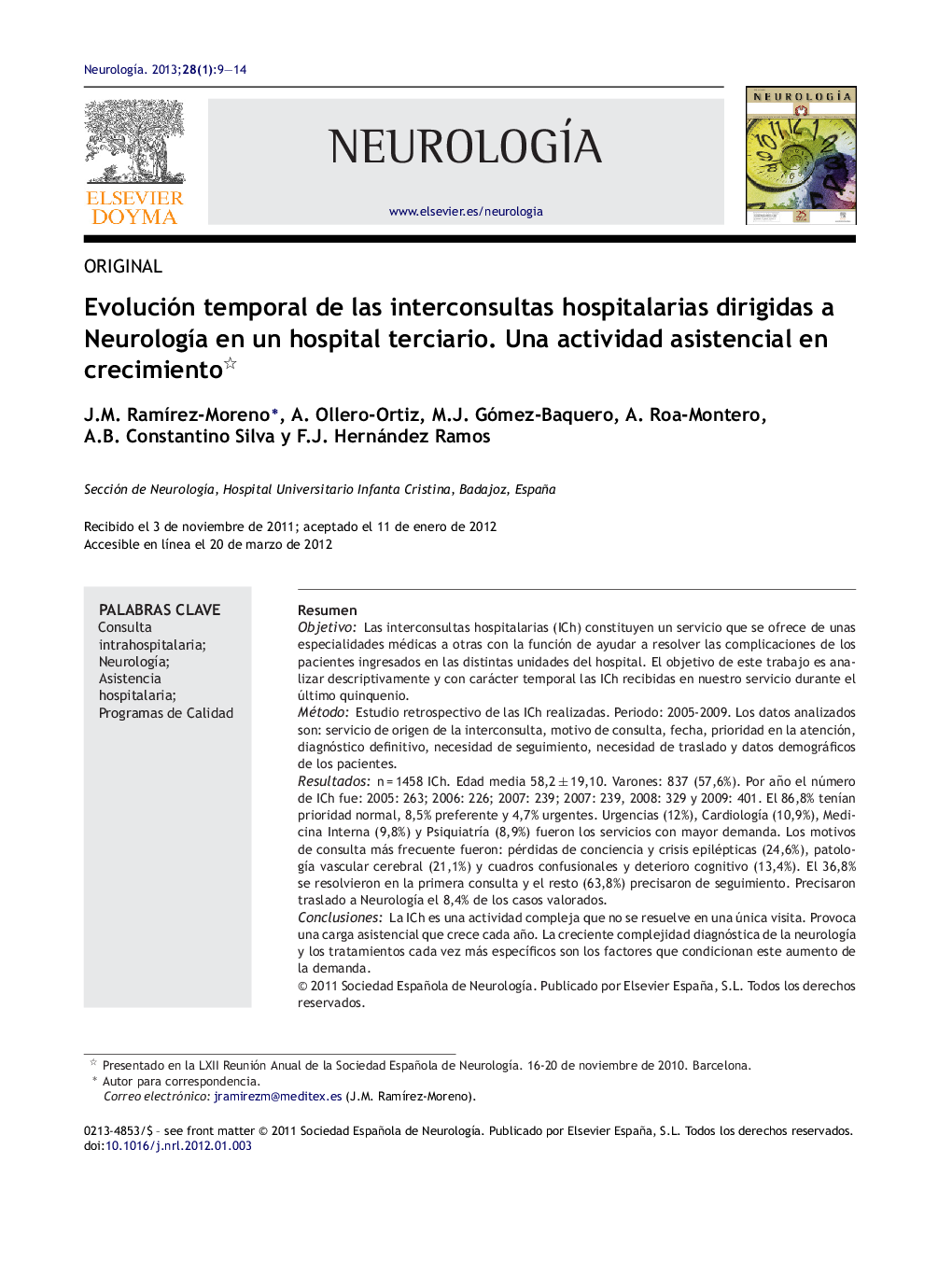| Article ID | Journal | Published Year | Pages | File Type |
|---|---|---|---|---|
| 3075940 | Neurología | 2013 | 6 Pages |
ResumenObjetivoLas interconsultas hospitalarias (ICh) constituyen un servicio que se ofrece de unas especialidades médicas a otras con la función de ayudar a resolver las complicaciones de los pacientes ingresados en las distintas unidades del hospital. El objetivo de este trabajo es analizar descriptivamente y con carácter temporal las ICh recibidas en nuestro servicio durante el último quinquenio.MétodoEstudio retrospectivo de las ICh realizadas. Periodo: 2005-2009. Los datos analizados son: servicio de origen de la interconsulta, motivo de consulta, fecha, prioridad en la atención, diagnóstico definitivo, necesidad de seguimiento, necesidad de traslado y datos demográficos de los pacientes.Resultadosn = 1458 ICh. Edad media 58,2 ± 19,10. Varones: 837 (57,6%). Por año el número de ICh fue: 2005: 263; 2006: 226; 2007: 239; 2007: 239, 2008: 329 y 2009: 401. El 86,8% tenían prioridad normal, 8,5% preferente y 4,7% urgentes. Urgencias (12%), Cardiología (10,9%), Medicina Interna (9,8%) y Psiquiatría (8,9%) fueron los servicios con mayor demanda. Los motivos de consulta más frecuente fueron: pérdidas de conciencia y crisis epilépticas (24,6%), patología vascular cerebral (21,1%) y cuadros confusionales y deterioro cognitivo (13,4%). El 36,8% se resolvieron en la primera consulta y el resto (63,8%) precisaron de seguimiento. Precisaron traslado a Neurología el 8,4% de los casos valorados.ConclusionesLa ICh es una actividad compleja que no se resuelve en una única visita. Provoca una carga asistencial que crece cada año. La creciente complejidad diagnóstica de la neurología y los tratamientos cada vez más específicos son los factores que condicionan este aumento de la demanda.
ObjectiveIn-hospital consultation (IHC) is a service that some medical specialties provide to others with the aim of resolving complications in patients admitted to different hospital units. The aim of this study is to perform a descriptive analysis and longitudinal study of IHCs received in our department during the last 5 years.MethodA retrospective study was conducted on the IHCs made within the period 2005-2009. The data analysed were as follows: department of origin of the IHC, reason for consult, date, priority of care, definitive diagnosis, need for follow-up, need for transfer, and the demographic data of the patients.ResultsThere were a total of 1458 IHCs in the period studied. The mean age of the patients was 58.2 ± 19.10 years, and 837 (57.6%) were males. The number of IHCs per year was: 2005: 263; 2006: 226; 2007: 239; 2007: 239, 2008: 329 and 2009: 401. The majority (86.8%) had normal priority, 8.5% high priority, and 4.7% were urgent. The Emergency Department (12%), Cardiology (10.9%), General Medicine (9.8%) and Psychiatry (8.9%) were the services with the highest demand. The most frequent reasons for consulting were loss of consciousness and epileptic seizures (24.6%), cerebral vascular disease (21.1%), and confusional states and cognitive impairment (13.4%). Over one third (36.8%) were resolved in the first consultation, and the remainder (63.8%) required follow up. Of all the cases assessed, 8.4% required transfer to Neurology.ConclusionsIHC is a complex activity that may not resolve all questions in a single visit. It involves a health care burden which is increasing annually. The increasing diagnostic complexity of the neurology, as well as the increasingly more specific treatments are the factors that lead to this higher demand.
